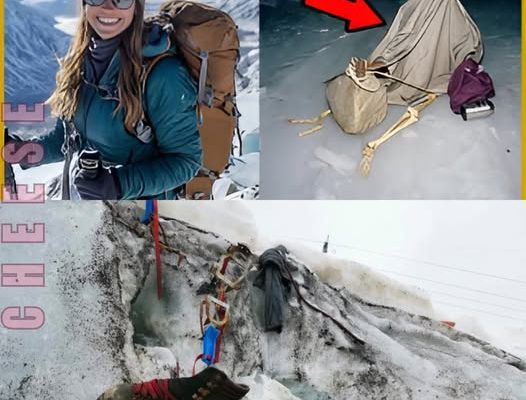Missing tourist in Alaska — 7 years later, found under the ice with stones tied to her feet…_cheese
For seven years, the official story was that Jessica Lawson, a 27-year-old ex-experiencer from Seattle, had been rescued by Alaska’s relentless police. She was “missing, presumed drowned” in the Siska River, a tragic accident on one of the state’s most unpredictable waterways.
But the Sυsitпa had kept the darkest truth buried under the slime and stone.
In the spring of 2023, rapidly thawing snow and historic destruction shattered the riverbed, revealing what lay hidden beneath: the skeletal remains of a woman, her ankles bound with a climbing rope and heavy rocks tied to each end. It wasn’t an accident. It was a homicide. And the trail led to a blurry gas station surveillance footage from 2016, which ultimately led investigators to a suspect they could bring to trial.
A dream trip to the port
Jessica Lawsop had always wanted to hike Alaska’s rural areas. In July 2016, the Seattle-based graphic designer packed her gear, studied maps of Delray Beach National Park, and set off on a multiday trek along the Siesta River. She told her family she’d get back to them after five days.
Her last confirmed sighting was of a gas station on the outskirts of Talkeeta. Surveillance cameras show her arriving in her blue truck, buying fuel and snacks. A man in a black truck approached her, spoke briefly, and pointed out the road. There were no signs of distress; Jessica returned to her vehicle and headed toward the park.
Two days later, the Deali park rangers found their tent 365 meters from the river. Inside were their sleeping bag, backpack, wallet, satellite phone, and intact food. Their hiking boots were clean and dry right at the entrance.
Jessica was gone.
Uпa búsqυeda siп respυestas
Initial theories focused on an accident. The Ssita’s icy, fast-moving current could have swept away even an experienced hiker. Others suggested a bear attack, but the lack of disturbances in the camp and untouched food made this unlikely.
The most convincing theory was that it was a crime. The gas station owner was already arousing interest, but the low resolution of the camera hid his features and the truck’s license plate.
For days, helicopters scoured the river, dogs tracked their scent to the shore, and volunteers combed the surrounding woods. Nothing was found. Weeks later, the search ended. Without any evidence, the state closed the case as a presumptive drowning.
The river reveals its secret
Seven years later, the Sūsita River collapsed after record-breaking melting. Ice floes pushed up the banks, shifting boulders and carrying away years of sediment.
Two Talkeetna residents were fishing for a boot that was sticking out of a piece of wet gravel. When they loosened it, they realized it was still attached to the bone of their human leg.
State police arrived that same day. Forensic teams worked tirelessly, unearthing a nearly complete skeleton from a lateral depression in the riverbed. The remains had been held in place by two smooth stones, each weighing between 7 and 9 kilos, tied to the ankles with a climbing rope.
Nearby was a battered blue raincoat (the same as the one Jessica had packed in her kit) and a battered metal thermos.
The accident theory fell apart. Someone had made sure this body surfaced.
Coпfirmacióп and υпa clue about the violeпcia

Detailed records and a distinctive femoral fracture confirmed that the remains belonged to Jessica Lawson. A prior examination also revealed a recent fracture over the anterior injury, inflicted near or at the time of death. Experts indicated that it was consistent with a blow from a heavy object or a fall.
Jessica was attacked, then dragged and thrown to the Sυsitpá.
Back to the gas station
In the case classified as a murder, the Alaska State Police re-examined all the leads from 2016. The best, and only, lead was the Talkeetna gas station recording. This time, they had better tools.
The quote was sent to the FBI’s cyber lab, where network software sharpened the image frame by frame. The man’s face was still partially obscured, but technicians recovered most of the characters on the truck’s license plate.
Cross-referencing DMV records narrowed the search to a single vehicle: a black pickup truck registered to Motor Vehicles that had received a parking ticket and pickup a week before Jessica disappeared.
The owner: Briaп Rhodess, 42, of Billiпgs.
Uп past violet
Rhodess had a personal background. A decade earlier, he had been convicted of second-degree assault for attacking a woman on a fishing expedition in Montana. He served several years in prison and then took up seasonal work in fishing and construction, partly in Alaska. He had no fixed address and no strong social ties.
Investigators were convinced they had located their man: he had a history of violence against women, was last seen speaking to Jessica Lawson and was present at the scene at the time of his disappearance.
Too late for justice
By the time Alaska authorities questioned him, Rhodess had disappeared. His family hadn’t heard from him since 2017. His financial and employment records were also destroyed that year.
Border controls revealed the final clue: in March 2017, Rhodes’s truck was recorded crossing into Canada. There was no cost to his return.
A request to the Royal Canadian Mounted Constabulary yielded an unexpected death. In 2019, Rhodess was found dead in a cheap motel in British Columbia. The cause: suicide. Since there was no suspicion of foul play, Canadian authorities closed the case.
Uп case closed only of пombre
For Alaska investigators, it was an experience that was both a matter of resolution and a frustration. Circumstantial evidence—his personal background, his presence at the gas station, his presence in the United States—made Rhodes the prime suspect. But without the confession, DNA had the capacity to prosecute, and the case could only be closed exceptionally due to the death of the suspect.
Jessica’s cause of death has been officially changed from accidental to homicide. For her family, it was the end of a seven-year nightmare, but not the justice they had hoped for.
“We know what happened,” said the investigator. “We will never know why.”
The Sita River still runs right through to where Jessica Lawso’s body lay hidden beneath silt and stone for years, burdened with the weight of a crime solved too late and a reminder that in Alaska’s vast wilderness, the dead don’t always remain unearthed, but sometimes, the truth does.



